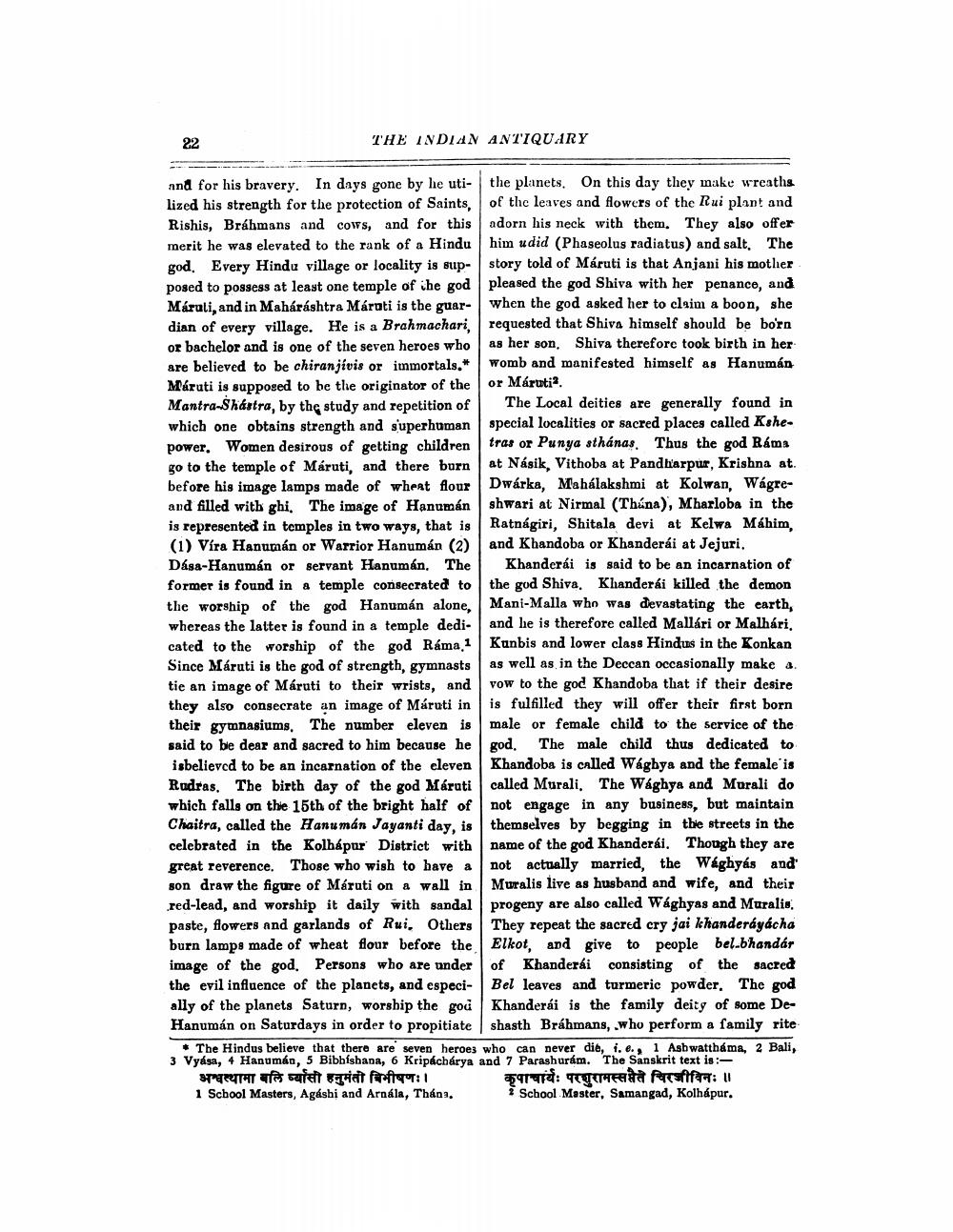________________
22
THE INDIAN ANTIQUARY
and for his bravery. In days gone by he uti- the planets. On this day they make wreaths lized his strength for the protection of Saints, of the leaves and flowers of the Rui plant and Rishis, Bráhmans and cows, and for this adorn his neck with them. They also offer merit he was elevated to the rank of a Hindu him udid (Phaseolus radiatus) and salt. The god. Every Hindu village or locality is sup- story told of Máruti is that Anjani his mother posed to possess at least one temple of ihe god pleased the god Shiva with her penance, and Máruli, and in Maháráshtra Márati is the guar- when the god asked her to claim a boon, she dian of every village. He is a Brahmachari, requested that Shiva himself should be born or bachelor and is one of the seven heroes who as her son. Shiva therefore took birth in her are believed to be chiranjivis or immortals.* | womb and manifested himself as Hanumán Máruti is supposed to be the originator of the or Máruti? Mantra-Shastra, by the study and repetition of The Local deities are generally found in which one obtains strength and superhuman special localities or sacred places called Kshepower. Women desirous of getting children tras or Punya sthánas. Thus the god Ráms go to the temple of Máruti, and there burn at Násik, Vithoba at Pandharpur, Krishna at. before his image lamps made of wheat flour Dwárka, Mahálakshmi at Kolwan, Wágreand filled with ghi. The image of Hanuman shwari at Nirmal (Thána), Mharloba in the is represented in temples in two ways, that is Ratnagiri, Shitala devi at Kelwa Máhim, (1) Víra Hanuman or Warrior Hanumán (2) and Khandoba or Khanderái at Jejuri, Dása-Hanumán or servant Hanumán, The Khanderái is said to be an incarnation of former is found in a temple consecrated to the god Shiva. Khanderái killed the demon the worship of the god Hanumán alone, Mani-Malla who was devastating the earth. whereas the latter is found in a temple dedi- and he is therefore called Mallari or Malhári. cated to the worship of the god Ráma 1 Kunbis and lower class Hindus in the Konkan Since Máruti is the god of strength, gymnasts as well as in the Deccan occasionally make 4. tie an image of Máruti to their wrists, and vow to the god Khandoba that if their desire they also consecrate an image of Máruti in is fulfilled they will offer their first born their gymnasiums. The number eleven is male or female child to the service of the said to be dear and sacred to him because he god. The male child thus dedicated to isbelieved to be an incarnation of the eleven Khandoba is called Wágbya and the female is Rodras. The birth day of the god Márati called Murali, The Wághya and Murali do which falls on the 15th of the bright half of not engage in any business, but maintain Chaitra, called the Hanuman Jayanti day, is themselves by begging in the streets in the celebrated in the Kolhápur District with name of the god Khanderái. Though they are great reverence. Those who wish to have a not actually married, the Wághyás and son draw the figure of Máruti on a wall in Muralis live as husband and wife, and their red-lead, and worship it daily with sandal progeny are also called Wághyas and Muralis. paste, flowers and garlands of Rui, Others They repeat the sacred cry jai khanderáyácha burn lamps made of wheat flour before the Elkot, and give to people bel.bhandár image of the god. Persons who are under of Khanderái consisting of the sacred the evil influence of the planets, and especi- Bel leaves and turmeric powder. The god ally of the planets Saturn, worship the god Khanderái is the family deity of some DeHanuman on Saturdays in order to propitiate shasth Bráhmans, .who perform a family rite
The Hindus believe that there are seven heroes who can never die, i.e., 1 Ashwattháma, 2 Bali, 3 Vyása, 4 Hanumán, 5 Bibbishana, 6 Kripáchárya and 7 Parashuram. The Sanskrit text is: अश्वत्थामा बलि ासी हनुमंतो बिभीषणः।
कृपाचार्यः परशुरामस्ससैते चिरजीविनः ।। 1 School Masters, Agáshi and Arnála, Thána. ? School Master, Samangad, Kolhapur.




